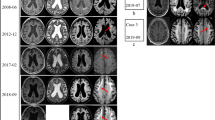Summary
A marked cutaneous axonal dystrophy has been observed electronmicroscopically for the first time in the skin of three patients: (a) lesion of pityriasis lichenoides chronica in a patient with bronchogenic carcinoma, (b) non involved skin of a patient with malignant melanoma and (c) non involved skin of a patient with gout and retinal damage after prolonged use of chloroquine. The affected myelinated and non myelinated axons showed distinet alterations of mitochondria and multiple osmiophilic lamellated bodies (LK). These changes were interpreted as a (poly-)neuropathy, due to the influence of toxie systemic agents, such as malignant tumor and abuse of drugs. Chloroquine is known to induce neural damage. Moreover, some other compounds (ergotamine. ethaverine, analgetic preparations) may also be responsible for the drug-induced axonal dystrophy described in this study.
Zusammenfassung
An den Hautnerven von drei Kranken (Bronchial-Carcinom, metastasierendes malignes Melanom, Gicht mit chronischem Resochin®-Schaden) wurde erstmalig eine cutane axonale Dystrophie beobachtet, die mit Mitochondrien-Alterationen und dem Auftreten multipler osmiophiler Einschlüsse (lamelläre Körper, LK) einhergeht. Diese Veränderung wurde als eine nucleo-distale (Poly-)Neuropathie interpretiert. hervorgerufen durch den Einfluß systemischer Noxen. Als solche wurden bei den hier beschriebenen Fällen metastasierende Geschwülste (Bronchial-Carcinom und malignes melanom) sowie ein chronischer Mißbrauch von Medikamenten, insbesondere von Resochin, angesehen.
Similar content being viewed by others
Literatur
Abraham, R., Hendy, R. J.: Irreversible lysosomal damage induced by chloroquine in the retinae of pigmented and albino rats. Exp. Molec. Path.12, 185–200 (1970)
Babel, J., Bischoff, A., Spoendlin, H.: Ultrastructure of the peripheral nervous system and sense organs. Stuttgart: G. Thieme, 1970
Blümcke, S., Niedorf, H. R.: Elektronenmikroskopische Untersuchungen an Lamellenkörpern in regenerierenden peripheren Nerven. Beitr. path. Anat.131, 38–62 (1965)
Dyck, P. J., Bailey, A. A., Olszewski, J.: Carcinomatous neuromyopathy: A case of sensory neuropathy and myopathy with onset three and one-half years before clinical recognition of the bronchogenic carcinoma. Canad. med. Ass. J.79, 913–916 (1958)
Gibbels, E.: Medikamentös-toxische Polyneuropathien. Akt. neurol.1, 175–180 (1974)
Henson, R. A., Russel, D. S., Wilkinson, M.: Carcinomatous neuropathy and myopathy. a clinical and pathological study. Brain77, 82–121 (1954)
Holtzman, E., Novikoff, A. B.: Lysosomes in the rat sciatic nerve following crush. J. Cell. Biol.27, 651–669 (1965)
Horton, B. T., Peters, G. A.: Clinical manifestation of excessive use of ergotamine preparation and management of withdrawal effect; report of 52 cases. Headache2, 214–227 (1963)
Itabashi, H. H., Kökmen, E., Mich, A. A.: Chloroquine neuromyopathy. Arch. Path.93, 209–218 (1972)
Kidd, M.: Alzheimer's disease: an electron microscopical study. Brain87, 307–327 (1964)
Klinghardt, G.: Experimentelle Schädigungen von Nervensystem und Muskulatur durch Chlorochin: Modelle verschiedenartiger Speicherdystrophien. Acta neuropath. (Berl.)28, 117–141 (1974)
Lampert, P. W., Cressman, M.: Axonal regeneration in the dorsal columns of the spinal cord of adult rats. Lab. Invest.12, 825–839 (1964)
Lampert, P. W.: A comparative electron microscopic study of reactive degenerating, regenerating and dystrophic axons. J. Neuropath. exp. Neurol.26, 345–368 (1967)
Lawwill, T., Appleton, B., Altstatt, L.: Chloroquine accumulation in human eyes. Amer. J. Ophthal.65, 530–532 (1968)
Loftus, L. R.: Peripheral neuromyopathy following chloroquine therapy. Canad. med. Ass. J.89, 917–920 (1963)
Lüllmann, H., Lüllmann-Rauch, R., Wassermann, O.: Arzneimittel-induzierte Phospholipidspeicherkrankheit. Dtsch. med. Wschr.98, 1616–1625 (1973)
O'Daly, J. A., Imeada, T.: Electron microscopic study of Wallerinan degeneration in cutaneous nerves caused by mechanical injury. Lab. Invest.17, 744–766 (1967)
Orfanos, C. E., Mahrle, G.: Ultrastructure and cytochemistry of human cutaneous nerves. J. invest. Derm.61, 108–120 (1973)
Read, W. K., Bay, W. W.: Basic cellular lesion in chloroquine toxicity. Lab. Invest.24, 246–259 (1971)
Roizin, L., Kaufman, M. A., Akai, K., Carsten, A. L., Liu, J. C.: CNS axonal dystrophy following delayed X-irradiation in monkeys, p. 237–246. VI. Congr. Int. de Neuropathologie Paris 1970. Paris: Masson, 1970
Samuels, St., Gonatas, N. K., Weiss, M.: Formation of the membranous cytoplasmic bodies in Tay-Sachs disease: an in vitro study. J. Neuropath. exp. Neurol.24, 256–264 (1965)
Schröder, J. M.: Die Feinstruktur markloser (Remak'scher) Nervenfasern bei der Isoniazid-Neuropathie. Acta neuropath. (Berl.)15, 156–175 (1970)
Sluga, E.: Polyneuropathien: Typen und Differenzierung, Ergebnisse bioptischer Untersuchungen. Schriftenreihe Neurologie, Band 14, Berlin-Heidelberg-New York: Springer, 1974
Stern, J.: The induction of ganglioside storage in nervous system cultures. Lab. Invest.26, 509–514 (1972)
Terry, R. D., Weiss, M.: Studies in Tay-Sachs disease. II. Ultrastructure of the cerebrum. J. Neuropath. exp. Neurol.22, 18–55 (1963)
Wallace, B. J., Volk, B. W., Schneck, L., Kaplan, H.: Fine structural localization of two hydrolytic enzymes in the cerebellum of children with lipidoses. J. Neuropath. exp. Neurol.25, 76–96 (1966)
Webster, H. F.: Transient, focal accumulation of axonal mitochondria during the early stages of Wallerian degeneration. J. Cell. Biol.12, 361–383 (1962)
Yu, C. M., Bakay, L., Lee, J. C.: Ultrastructure of the central nervous system after prolonged hypoxia. I. Neuronal alterations. Acta neuropath. (Berl.)22, 222–234 (1972)
Author information
Authors and Affiliations
Additional information
Herrn Prof. Schneider, Tübingen, zum 65. Geburtstag gewidmet.
Rights and permissions
About this article
Cite this article
Runne, U., Orfanos, C.E. Tumor- und arzneimittel-induzierte cutane axon-dystrophie. Arch. Derm. Res. 254, 55–66 (1975). https://doi.org/10.1007/BF00561535
Received:
Issue Date:
DOI: https://doi.org/10.1007/BF00561535




